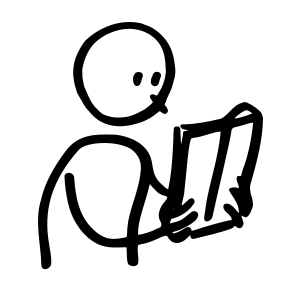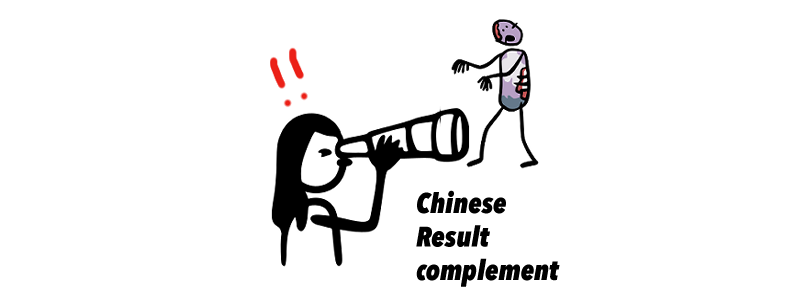Grammar Point:
The result complement is called 结果补语 jiéguǒ bǔyǔ in Chinese. It is just like its name, used to describe the result of a verb.
What is the result complement?
In Chinese grammar, a result complement 结果补语 jiéguǒ bǔyǔ is a grammatical structure that expresses the result or outcome of an action or event. It is typically used to modify a verb or an adjective and follows the verb or adjective it modifies.
For instance, in the sentence “他喝完水 tā hē wán shuǐ,” which means “He has finished drinking the water,” the result complement “完 wán,” meaning “finish,” conveys the outcome of the action of drinking.
In English, different words are used to differentiate between the action and result when discussing outcomes. For example, “to look” and “to see,” or “to listen” and “to hear.” In Chinese, result complements are appended to the action verb to indicate whether the action was completed, successful or unsuccessful, done, received and so on.

看 kàn: Describing the action of setting your eyes on something.

看见 kànjiàn: By adding result complement 见 jiàn implies that after setting your eyes on something, you register or receive the information that enters your vision.
RC in this article we are going to learn:
| Verb (action) | + | Result complement | = | Explanation |
|---|---|---|---|---|
| 听 tīng (listen) | + | 清楚 qīngchǔ (clear) | = | 听清楚 tīngqīngchu (to listen clearly) |
| 写 xiě (write) | + | 错 cuò (wrong, mistake, error) | = | 写错 xiěcuò (to write something wrong) |
| 洗 xǐ (wash) | + | 干净 gānjìng (clean) | = | 洗干净 xǐgānjìng (to wash something cleaning) |
| 吃 chī (eat) | + | 完 wán (finish) | = | 吃完 chīwán (to finish eating) |
| 看 kàn (look, watch, read) | + | 懂 dǒng (understand) | = | 看懂 kàndǒng (to read and understand it) |
| 做 zuò (do, make) | + | 好 hǎo (finish, done, ready) | = | 做好 zuòhǎo (to finish something, make something done) |
| 学 xué (learn) | + | 会 huì (learn and get it) | = | 学会 xuéhuì (to master) |
Structure
S + V + RC + O
你寫錯了兩個漢字你写错了两个汉字
You wrote two Chinese characters incorrectly.
我要冰拿鐵換燕麥奶,你別買錯了我要冰拿铁换燕麦奶,你别买错了
I want an iced latte with oat milk instead of regular milk. Please don’t get it wrong.
這個句子你看懂的話,請回答我的問題这个句子你看懂的话,请回答我的问题
If you understand this sentence, please answer my question.
衣服請你洗乾淨再穿衣服请你洗干净再穿
Please wash (clean) your clothes before you wear them.
老師的話你聽清楚了嗎?老师的话你听清楚了吗?
Did you hear the teacher’s words clearly?
結婚十年,我學會了妥協结婚十年,我学会了妥协
After ten years of marriage, I have learned to compromise.
Negation
S + 沒/不 + V + RC + O
Both 不 bù and 沒 méi are possible negation particles in this structure. However, it is important to remember that 不 bù negates verbs usually about the present or future, whereas 沒 méi is usually used for things in the past. As a result, 没 méi is heard more often than 不 bù in this structure.
這道題我沒學會这道题我没学会
I did not master (understand) this question.
我還沒吃完飯我还没吃完饭
I haven’t finished my meal yet.
他如果不做好他的工作,就別請他了他如果不做好他的工作,就别请他了
If he doesn’t work well, don’t hire him.
其實你沒聽懂我在說什麼,對吧?其实你没听懂我在说什么,对吧?
You don’t understand what I’m saying, do you?
Aspect Particles and 把
- Don’t use result complement with 着 zhe
The particle 着 zhe is used to indicate that an action is ongoing or in progress, and therefore cannot be used with result complements. Result complements indicate the outcome or completion of an action, which is incompatible with the idea of an ongoing or in-progress action.
我吃著完了飯我吃着完了饭 ❌
- 了1 and 了2 le are the most common particles to use with RC.
我準備好了我准备好了
I am ready.
你覺得你看懂了嗎?你觉得你看懂了吗?
Do you think you understand it?
孩子寫完了作業孩子写完了作业
The child finished his homework.
But, if the character 了1 le means an action is completed, then why do we need the complement 完 wán (finish)?
我寫了作業我写了作业
I wrote homework.
(What I did was write, but it’s unclear if I completed the entire homework. It’s possible that I stopped halfway and did something else.)
我寫完了作業我写完了作业
I finished writing my homework.
(It clarifies that I have completely finished my entire homework.)
- It is also possible to use 过 guò with it, but in 95% of situations, we prefer to just drop the RC.
你看(見)過習近平?你看(见)过习近平?
Have you seen Xi Jinping?
我聽(見)過中國的國歌我听(见)过中国的国歌
I have heard the Chinese national song.
- The 把 bǎ structure is another common structure used with direction complements. This is because both of them deal with the result of an action or the disposal of an object.
我沒把衣服洗乾淨我没把衣服洗干净
I didn’t wash the clothes clean.
他把我的名字寫錯了他把我的名字写错了
He wrote my name wrong.
哎呀!我把你的錢花完了哎呀!我把你的钱花完了
Oops! I spent all your money!
- Result Complement 2 (HSK 3)


